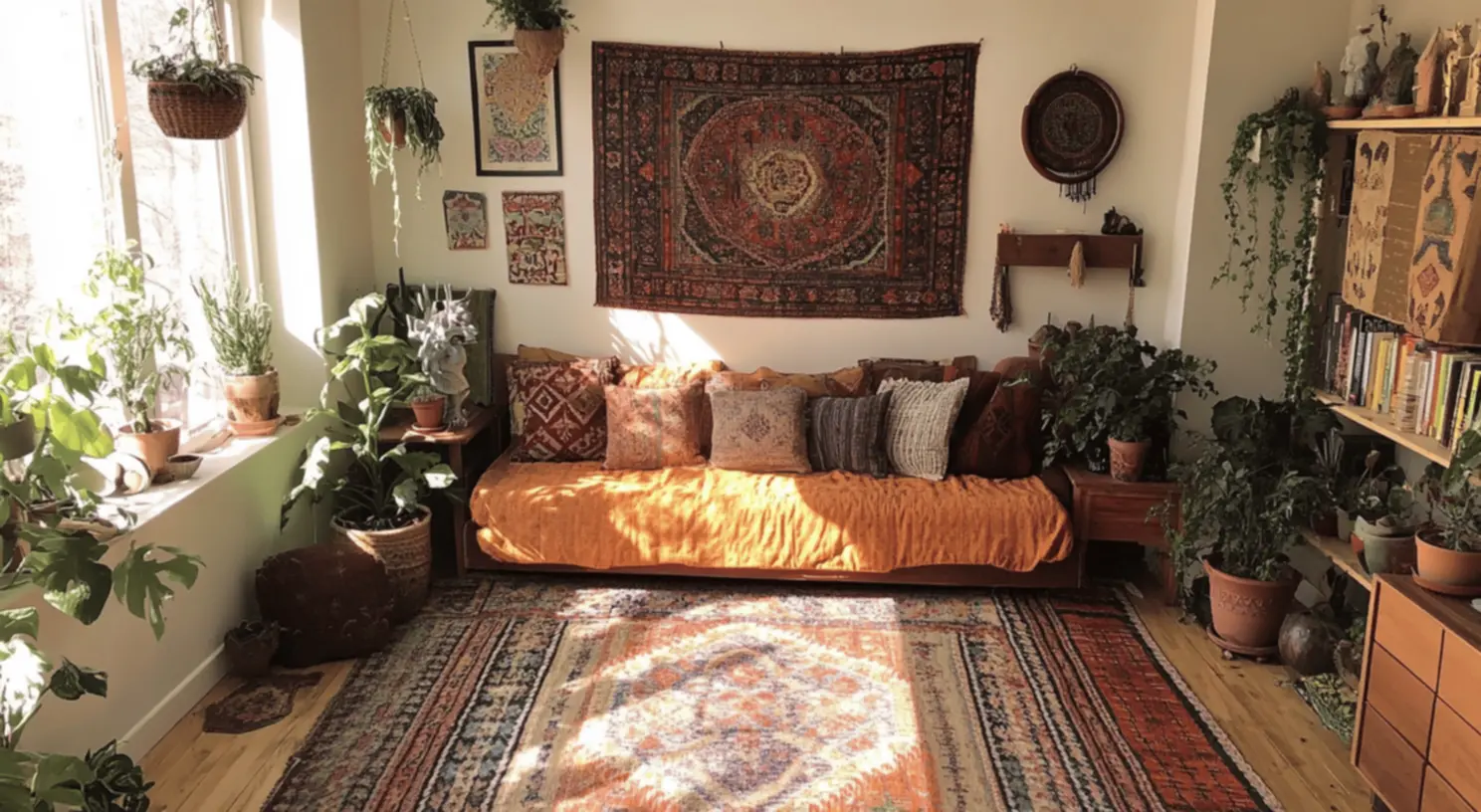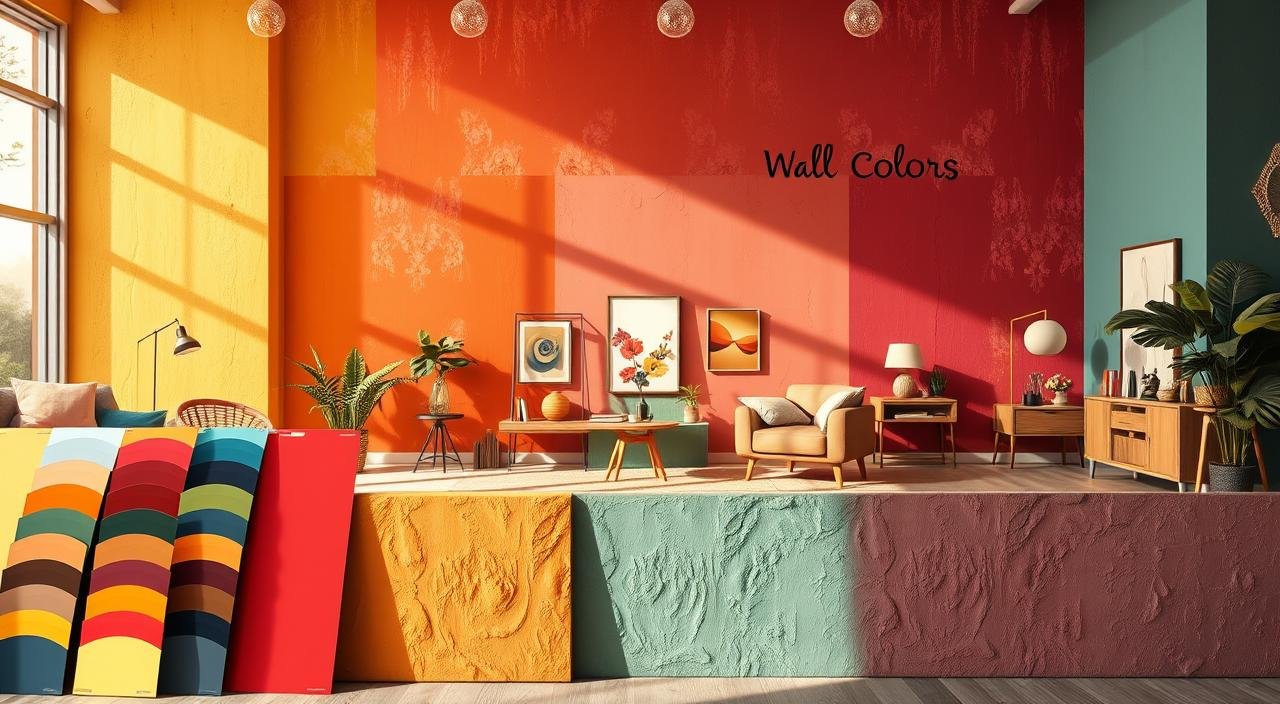10 Budget Home Construction Tips You Can’t Miss!
Ever wonder how to build your dream home without draining your savings? Many believe affordable home construction means settling for plain or flimsy spaces. But what if I told you that smart affordable home improvement ideas can slash costs *and* keep your vision intact? With construction costs rising, these budget home construction tips are your secret weapon to save thousands without sacrificing style.
Imagine looking at a blueprint, not a bank statement. By making smart choices, like tackling DIY tasks (painting, shelving) yourself while leaving wiring to pros, you can rein in expenses. Small moves like repurposing materials or timing purchases during sales add up fast. Let’s flip the script on the myth that luxury design needs a luxury budget!
Key Takeaways: Budget Home Construction Tips
- Planning ahead cuts costs more than last-minute fixes.
- DIY projects like painting save money while adding personal flair.
- Quality materials don’t have to break the bank—know where to splurge (foundations!) and where to simplify (decor).
- Seasonal sales and repurposed items slash expenses without hurting style.
- Professional help for complex tasks (plumbing, electrical work) prevents costly mistakes.
Understanding the Fundamentals of Budget Home Construction
Embarking on a budget home construction journey requires a solid grasp of the basics. We’ll explore the essential principles of budget home construction tips and economical construction planning. This will ensure your project stays on course without unnecessary expenses.
Why Planning Is Your Most Valuable Cost-Saving Tool
Effective planning prevents unexpected costs. Sarah saved $15k by planning her electrical layout early, avoiding costly wiring changes. Begin with a detailed design, account for site challenges, and purchase materials in bulk. Economical construction planning involves documenting every aspect, from electrical to plumbing, to avoid last-minute expenses.
Setting Realistic Financial Expectations
Your budget should cover more than just the structure. It should include:
- Land costs (20-25% of total budget)
- Design fees (10-15% for plans and permits)
- A 10-20% contingency fund for unexpected delays
Factor in additional costs for inspections, permits, and landscaping (5-10%). A smart move is to opt for pre-drawn house plans, which can cut design costs by up to 40%.
The Balance Between Quality and Cost
Quality doesn’t have to be expensive. Invest in the essentials: strong framing, waterproof roofs, and energy-efficient insulation. These elements are critical for long-term savings. For aesthetics, consider quartz over granite for countertops, saving half the cost. Discount outlets can also help with trim and lighting fixtures. A solid foundation is a long-term investment, while a cheap countertop may need to be replaced sooner.
Essential Budget Home Construction Tips for First-Time Builders
Embarking on a home project on a budget? We’ll explore strategies that transform smart decisions into significant savings. budget-friendly construction techniques don’t compromise on style. Instead, they focus on smart planning and practical selections.
Here’s your 5-step checklist to stay on track:
- Plan first, build later. A detailed blueprint prevents costly changes. Opt for open spaces to reduce material needs.
- Standard sizes = savings. Choose 8ft doors and 4x8ft sheet goods for lower costs. This tip alone can save thousands!
- Prioritize energy efficiency early. Invest in triple-pane windows or solar-ready roofs for long-term savings on utilities.
- Modular sections save time and labor. Prefab bathroom pods or panelized walls can cut framing time by 30%+.
- Shop material sales. Follow Home Depot or Lowes clearance events for discounted lumber, insulation, and flooring.
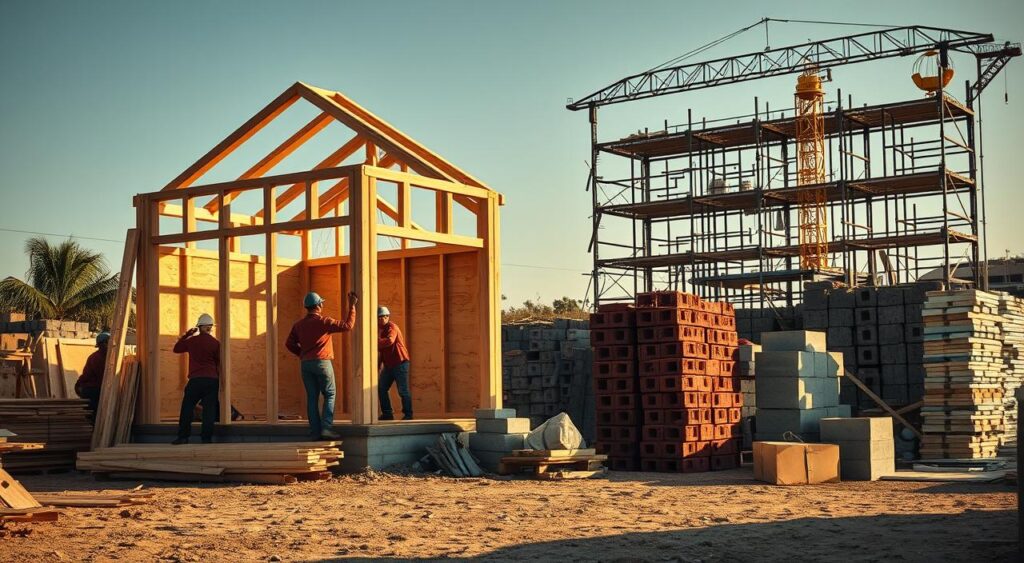
| Category | Money-Saving Tip | Example |
|---|---|---|
| Design | Use vertical space instead of expanding footprint | Loft bedrooms or mezzanine levels |
| Materials | Recycled building supplies | Salvaged wood beams from Habitat for Humanity ReStores |
| Contracting | Request bulk pricing from subcontractors | Negotiate HVAC installation discounts for full system purchases |
| Financing | Shop FHA loan options | VA loans offer 0% down payment options |
Remember, money-saving home renovation tips begin with a shift in mindset. Collaborate with suppliers during off-peak seasons for better prices. And always allocate 10% extra for unforeseen expenses. This approach prevents the need for last-minute, costly decisions. Your dream home can be affordable with the right planning!
Strategic Planning: The Foundation of Affordable Home Building
Let’s talk numbers. A home’s total cost splits into land (20–25%), materials (25–30%), and labor (20–25%). Cost-effective building strategies start here. By mapping every expense category upfront, you turn vague ideas into actionable plans. I’ve seen economic construction planning slash budgets by prioritizing what truly matters.
“Proper planning prevents costly mistakes 90% of the time.”
- Time your project: Off-season starts (Nov–Feb) cut labor costs 10–15%.
- Batch-buy materials in autumn to save 20%+ on bulk purchases.
- Use square floor plans to reduce material waste by up to 15%.
Start by dividing your budget into five buckets: land, materials, labor, permits, and finishes. Need a guide? Check this energy-saving checklist for maintenance hacks that compound savings over time. Use drywall instead of pine paneling? That’s a 40% savings right there.
Ask yourself: Does that vaulted ceiling add $10k but serve no real need? Trim the “wants” to fund essentials like insulation or wiring. A two-story design shaves 15% off land costs by building up—not out. And stick to standard 8-foot doors/windows to avoid custom-order markups. Every smart choice builds toward your dream home—without the sticker shock.
Designing for Efficiency: How to Maximize Every Square Foot
Ever ponder how to make every inch of your home a cost-effective gem? I’m here to unveil affordable home improvement ideas and budget-friendly construction techniques that can revolutionize your space. By creating spaces that serve multiple purposes, you can cut costs without losing out on style. Picture an open layout that feels expansive yet is more economical to construct—this is the essence of efficient design!
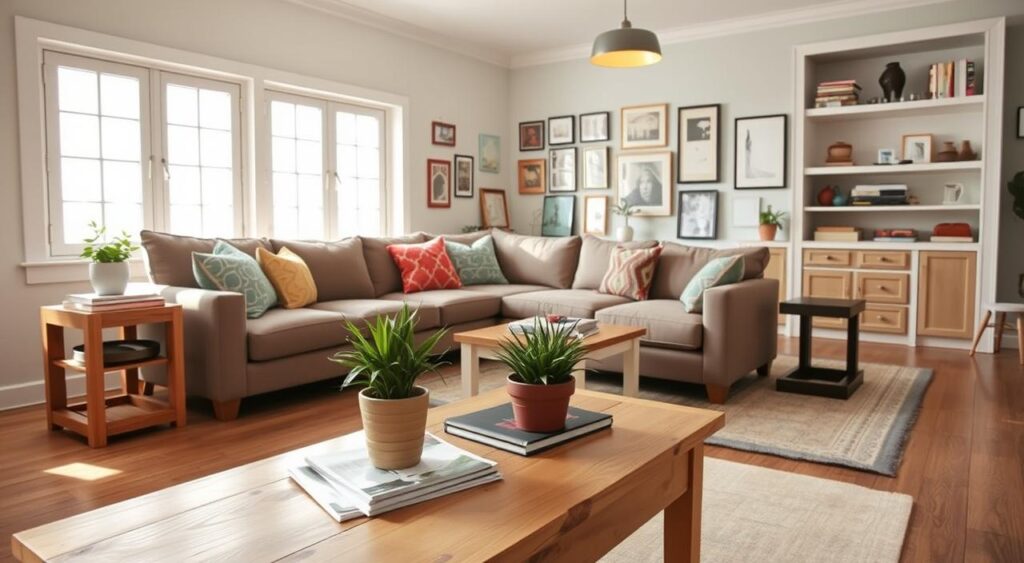
- Vertical storage: Wall-mounted shelves and floating racks utilize vertical space without adding extra square footage.
- Multi-functional zones: A dining area that also serves as a workspace with a transformable table saves both money and space.
- Smart daylighting: Floor-to ceiling windows and skylights reduce lighting costs while making rooms appear brighter and more spacious.
Let’s explore how these choices benefit your wallet:
| Strategy | Cost Impact |
|---|---|
| Compact floor plans | 40% less construction cost compared to larger homes |
| Modular prefab systems | 15-20% faster builds + material savings |
| Streamlined roofs (e.g., A-frame) | 20% reduction in roofing materials costs |
Small doesn’t mean sacrificing style, right? Think about this: A 1,200 sq ft home with smart layouts costs 30% less than a larger 2,000 sq ft design. By focusing on open floor plans and built-in furniture, you achieve function without extra space. Even the garage can merge with the main living area, saving thousands in separate structure costs.
Ready to craft a home that’s both chic and intelligent? Let’s transform every corner into a space-saving, budget-friendly triumph. Smart design doesn’t just save money; it creates luxury that will delight you for years to come.
Smart Material Selection: Getting Quality Without Breaking the Bank
Choosing the right materials is where budget home construction tips really shine. We’ll explore how to pick materials that save money without compromising quality. Low-cost building materials can be just as durable and stylish as their pricier counterparts—here’s how to find them.
Begin by exploring low-cost building materials that deliver big results. Fiber cement siding mimics wood’s charm but resists rot and pests—perfect for exteriors. Engineered wood beams? They’re stronger than solid wood and cheaper. Even bamboo flooring or recycled glass countertops blend sustainability with savings. These options slash upfront costs while boosting longevity.
“Quality doesn’t have to mean high cost. It’s about smart choices.”
Alternative Building Materials That Save Money
- Engineered hardwood for floors—durable and half the price of solid wood
- Quartz countertops—now matches laminate in cost but outlasts it by decades
- Recycled metal roofing—lightweight, fireproof, and 30% cheaper than asphalt shingles
When to Splurge and When to Save
Invest in windows with high energy ratings—they’ll slash heating bills long-term. But for trim or baseboards? Opt for standard profiles instead of custom cuts. Prioritize function over flair where it matters most.
Sourcing Discounted and Recycled Materials
Hunt for overstock at Home Depot’s clearance sections or check out Habitat for Humanity ReStores for gently used fixtures. Online platforms like Architectural Digest Surplus or Facebook Marketplace often list bulk materials at 50% off retail. Even local contractors’ leftover tiles or doors can be yours for a fraction of the cost.
Remember—sourcing creatively turns “waste” into treasure. Your dream home’s budget doesn’t have to break you. Start small, think smart, and watch savings stack up!
The DIY Approach: What to Tackle Yourself and What to Leave to Pros
Ever pondered the starting point for DIY construction on a budget? We’ll outline the strategy for dividing tasks between your DIY skills and professional help. First, evaluate your abilities: if you’re proficient with tools, tasks like painting or flooring can reduce labor costs by 50-75%. Yet, always prioritize safety—electrical work or structural changes should be handled by licensed professionals.
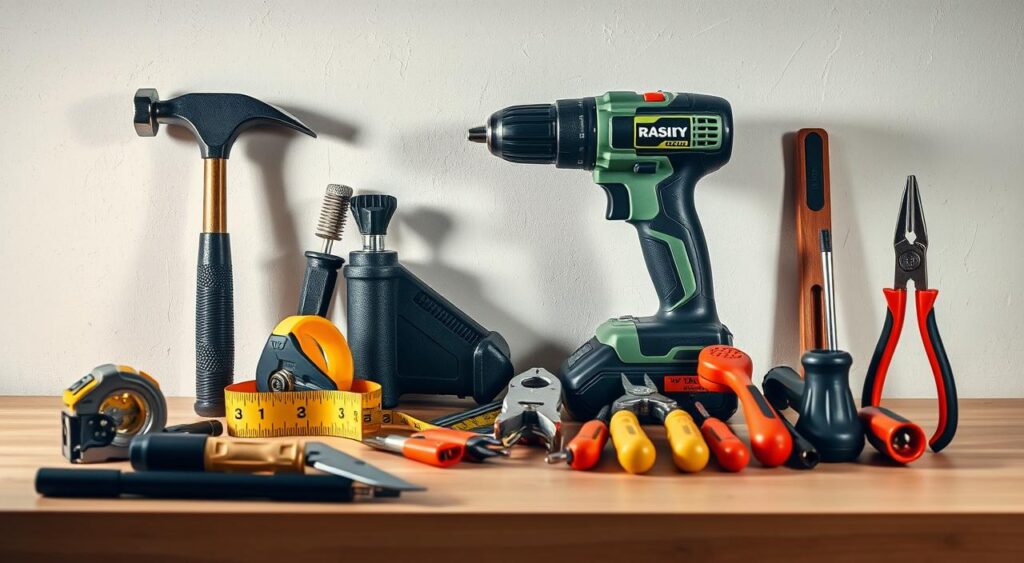
Here’s the strategy: DIY what you can, hire what you can’t. Begin with these affordable home improvement ideas:
| Category | DIY Projects | Professional Projects |
|---|---|---|
| Kitchen | Backsplash installation, cabinet painting | Gas line installation, major plumbing |
| Bathroom | Tile work, vanity refinishing | Electrical upgrades, structural changes |
| General | Painting, basic drywall | Roofing, foundation work |
Invest in core tools: a circular saw, drill, and laser level offer the most value. For inspiration, check out 15 proven projects from 17vibes.com. Also, 40% of DIY enthusiasts focus on sustainability—reusing materials can save money and enhance your eco-credentials!
Ready to begin? Start with smaller tasks like painting or deck staining and gradually increase your scope as you gain experience. But never compromise on permits or safety. Your wallet and your home’s integrity will appreciate it!
Working With Contractors on a Budget: Negotiation Strategies That Work

Building your dream home doesn’t have to drain your wallet. Smart negotiation with contractors can lead to significant savings without compromising on quality. Begin by shopping around—obtain at least three bids for a fair comparison. Request examples of their work within your budget range. Local contractors often offer lower prices due to reduced travel costs and better familiarity with local regulations.
To negotiate effectively:
- Ask for discounts if you pay cash or handle prep work yourself.
- Push for phased payments—never hand over more than 10-20% upfront.
- Time your project during their slow seasons (fall/winter) for better rates.
- Request written contracts with clear timelines, material specs, and warranties.
“Transparency builds trust. Contractors who share their costs openly are worth their weight in gold.”
Verify a contractor’s reputation by contacting two past clients. Inquire about their communication, project timelines, and problem-solving abilities. Saving money on home renovations also involves leveraging referrals for price reductions. For instance, suggesting a partnership with a trusted electrician can benefit both parties financially. Clear communication is key in budget-friendly construction, ensuring all parties understand the budget and deadlines.
Negotiation is a collaborative effort, not a competition. Showing respect for a contractor’s expertise can lead to price concessions. Be firm on your budget but open to adjusting details. With these strategies, you can achieve high-quality workmanship without overspending.
Cost-Effective Building Strategies for Different Home Sections
Every room in your home deserves smart choices that cut costs without cheapening quality. Let’s tackle each section with budget-friendly construction techniques that deliver lasting value. From the ground up, here’s how to make every dollar count:
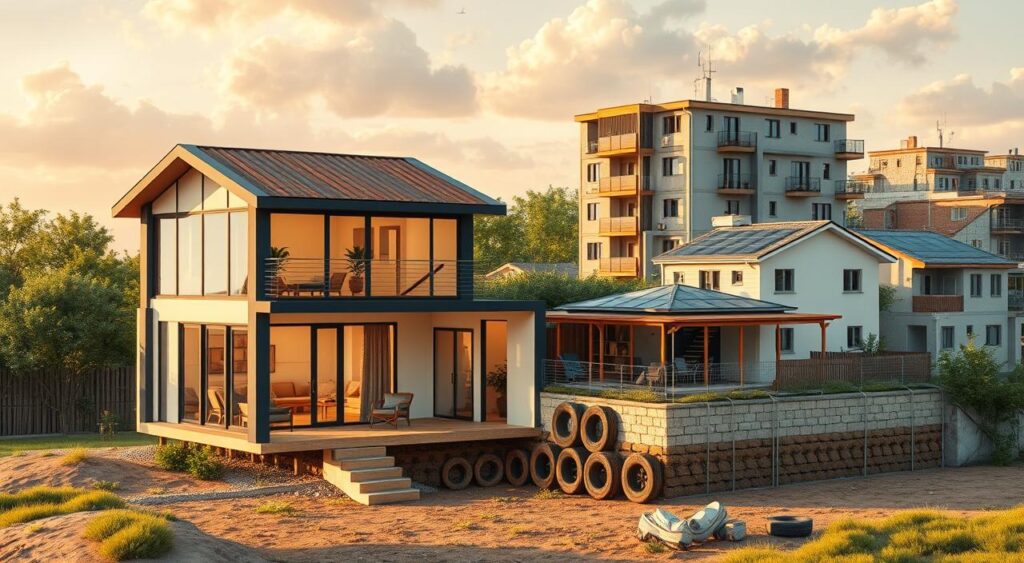
Foundation and Framing: Building Solid Without Overspending
Start strong with slab-on-grade foundations, which cost 20-30% less than full basements. Modular framing systems cut labor by 10-14%—prefabs save time and money by assembling 50% faster. Try advanced framing (24-inch spacing) to use 15% less lumber. Post-frame designs skip costly footings entirely—ideal for rural builds!
Affordable Roofing Solutions
Reclaimed wood shakes or metal panels slash material costs by 30%. Metal roofs last 50+ years—outlasting asphalt shingles. Want eco-friendly? Recycled steel options hit 20% lower than virgin materials. Pair with energy-efficient windows to cut heating bills 30% annually—smart long-term savings!
Budget-Friendly Interior Finishing Techniques
Tile strategically—use luxury materials only in high-traffic zones. Bamboo flooring costs 10-20% less than oak but lasts longer. Reclaimed wood accents add character at half the price of new lumber. Open layouts save on walls and doors—maximizing space while reducing costs. Need proof? Designing on 16-inch grids cuts material waste by 15%.
These cost-effective building strategies turn every room into a value-packed space. Mix and match ideas like modular framing with recycled materials for maximum savings. Ready to build smarter, not harder? Let’s get started!
Energy Efficiency: Long-Term Savings Through Smart Construction
Imagine reducing your energy bills by 25% or more with the right affordable home improvement ideas during construction. Let’s explore how economical construction planning can transform your home into a financial asset. Begin with passive solar design, a cost-free approach. Position windows southward to capture winter sun and use overhangs to shade them in summer. This method significantly reduces heating costs without the need for expensive technology.
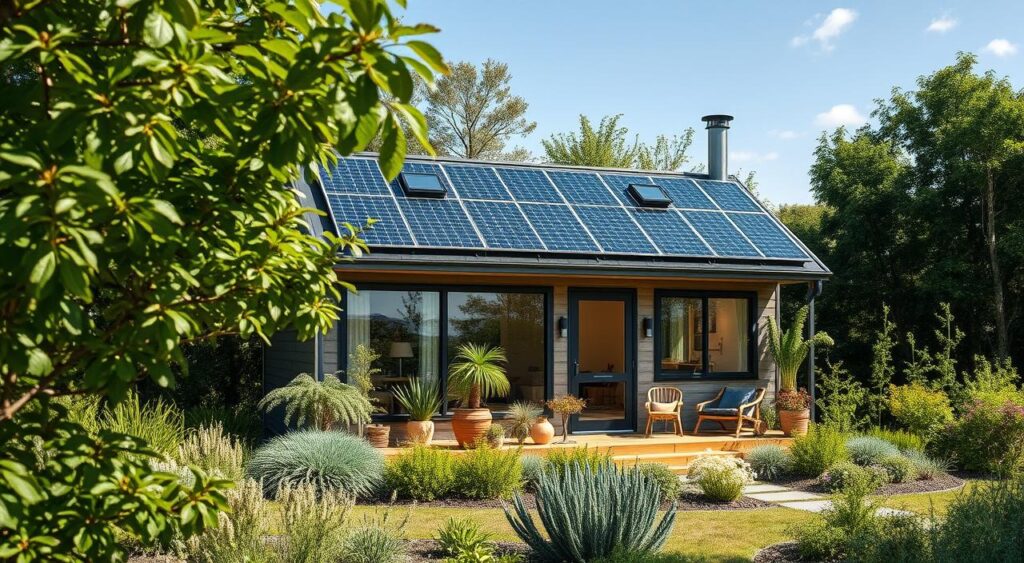
Insulation is essential. Options like spray foam or ICFs (insulated concrete forms) can reduce heating and cooling needs by up to 44%. Adding LED lighting and Energy Star appliances further enhances savings. Pre-wiring for solar panels now can prevent costly upgrades later.
- Install triple-pane windows with low U-values to seal in warmth
- Plant shade trees on the west side to cool your home naturally
- Wrap your water heater in an insulating jacket to cut standby heat loss
- Choose cool roofs with reflective materials to slash summer AC use
“A well-insulated building envelope can reduce energy demand by 30%—often for under $1,000 in extra costs.”
Don’t overlook the latest trends like modular construction. Prefab homes offer factory-installed insulation at competitive prices. Tax credits can cover up to 30% of solar panel costs, and ENERGY STAR certifications increase resale value. Every dollar invested here can lead to decades of savings. Let’s ensure your next project is a financial success, not a financial burden!
Inexpensive Housing Construction Hacks the Pros Don’t Tell You
Ready to transform your space without overspending? Let’s explore inexpensive housing construction hacks that turn everyday materials into designer-worthy upgrades. These tricks work like magic—proven by builders who keep them under wraps. Let’s break down how to steal their secrets.
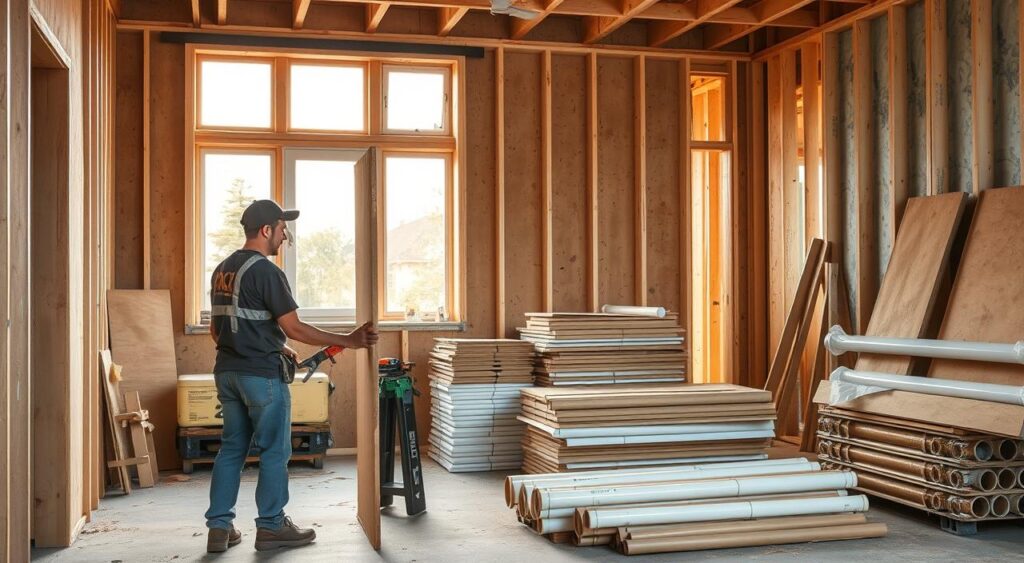
Repurpose What’s Already Around You
- Turn old shipping pallets into sturdy outdoor furniture with a coat of weatherproof paint.
- Use scrap drywall scraps to build custom shelves—sand and stain them for a rustic look.
- Recycle glass bottles as mosaic tiles for backsplashes—check out 17vibes’ guide for arranging patterns.
Smart Swaps for High-Cost Zones
Forget expensive renovations! Swap traditional options with these pro moves:
- Replace granite countertops with heat-treated concrete—polished to a glass-like shine.
- Install bamboo flooring instead of hardwood—it grows fast and costs half the price.
- Paint old doors in bold colors to mimic custom finishes—think turquoise for a coastal vibe.
Time-Savers That Double as Budget Saviors
Cut labor costs with these smart choices:
- Use pre-cut lumber bundles from Home Depot—pre-measured to reduce waste.
- Install peel-and-stick insulation panels to avoid hiring insulation crews.
- Opt for prehung doors—they come preassembled, saving 2-3 hours of labor per door.
Remember: money-saving home renovation tips aren’t just for pros. Start small—like repainting a thrift-store sideboard—and watch your home transform. Every dollar saved is another step toward your dream space!
Phasing Your Project: Building in Stages to Manage Costs
Ever dream of a sprawling backyard or a luxury master suite but worry about upfront costs? Economical construction planning through phasing lets you build your dream home one step at a time. Start with essentials like kitchens and bedrooms, then expand later. This approach turns big budgets into manageable chunks!
- Build core living spaces first to stay in your home while working
- Add outdoor spaces or luxury features when your budget allows
- Protect your investment by designing for future growth
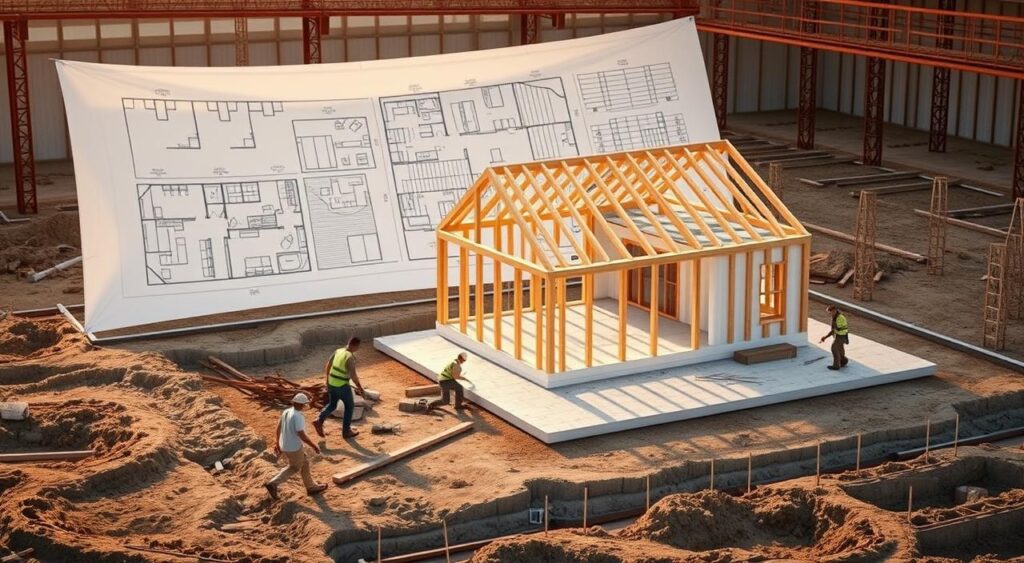
| Phase 1 (Now) | Phase 2 (Later) |
|---|---|
| Kitchen/dining | Home office |
| Bedrooms/bathrooms | Entertainment patio |
| Utility systems | Guest suite |
Pro tip: Include “expansion-ready” details like wider doorways and conduit runs for future wiring. This budget home construction tips strategy avoids costly surprises down the line! One homeowner in Texas saved $25k by adding a sunroom two years after their main house—using equity from their original investment to fund phase two.
Need help visualizing phases? I recommend sketching a timeline with your contractor. Prioritize flexibility in your initial design so each step builds on the last. Remember—phased projects aren’t just for the wealthy. With smart upfront planning, you can create a home that grows with your lifestyle and budget!
Low-Cost Building Materials That Don’t Sacrifice Quality
Looking to cut costs without skimping on style or strength? Let’s explore proven strategies for finding low-cost building materials that deliver big results. Whether renovating or starting from scratch, these smart choices save money without settling for “good enough.”
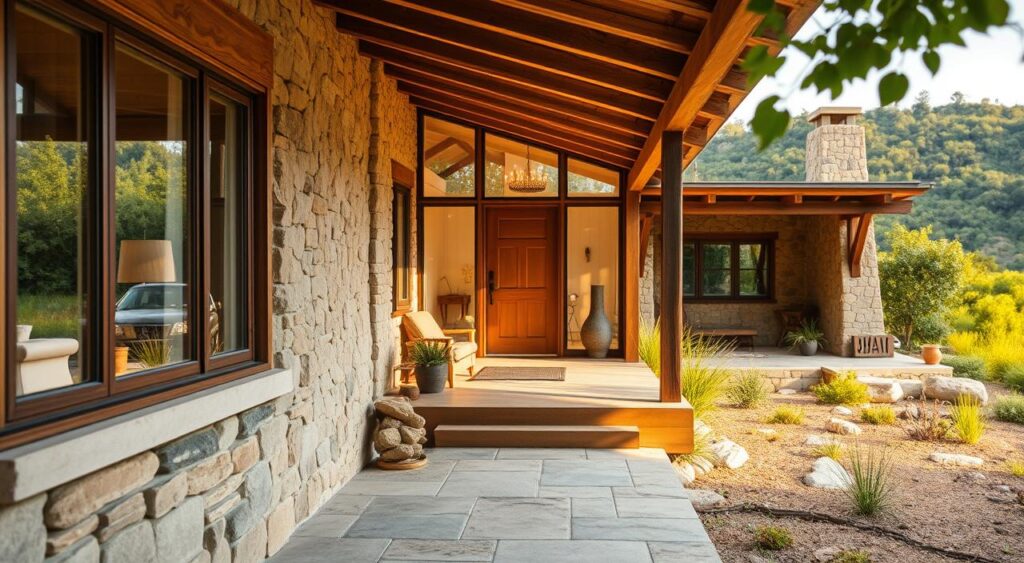
Sustainable Options That Save Money
Going green can also save you money. Bamboo flooring lasts longer than hardwood at 30-40% less cost. Reclaimed wood adds rustic charm while slashing material bills—think repurposed shipping containers or recycled metal accents. Double-glazed windows? They slash energy bills long-term, paying for themselves over time. Pro tip: Mix low-cost building materials like these with budget-friendly construction techniques to maximize savings!
- Bamboo: Durable, renewable, and perfect for floors or walls
- Recycled composite decking: Resists rot and lasts decades
- Shipping containers: Turn industrial waste into modern, affordable living spaces
Understanding Material Grades and When They Matter
Not all materials need top-tier quality. Here’s the cheat sheet:
| Material | Premium Grade Use | Budget Grade Use |
|---|---|---|
| Lumber | Structural beams | Ceiling joists or trim |
| Tile | High-traffic areas | Backsplashes or accent walls |
| Plumbing fixtures | Main bathrooms | Utility rooms or guest areas |
Save where it won’t compromise safety or longevity. Trust me—you’ll be surprised how far smart choices go!
Where to Find Clearance and Overstock Building Supplies
Score deals without sacrificing quality at these pro-approved spots:
- Manufacturer outlets (think Home Depot’s overstock sales)
- Local builder surplus stores
- Online auction sites like eBay or OfferUp
- Seasonal clearance events (winter window deals, summer tile markdowns)
Ask contractors for their leftover supplies too! Many are happy to part with extra materials at a fraction of retail prices.
Remember: Budget-friendly construction techniques like modular panels or panelized systems cut labor costs while maintaining quality. With these strategies, your dream home stays both stylish and affordable!
Economical Construction Planning: Avoiding Costly Mistakes
Every dollar matters when building your dream home. Let’s navigate through the chaos and focus on economical construction planning. This approach keeps your project on track. Cost-effective strategies begin with identifying risks early and addressing them before they escalate your budget.

| Common Pitfall | Smart Fix |
|---|---|
| No soil testing | Pay now—save later with professional site analysis |
| Vague contracts | Specify every detail to avoid change order chaos |
| Ignoring timelines | Build a phased schedule with buffer days |
- Always budget 10-15% for emergencies
- Shop for contractors like you’d compare appliances—get 3 quotes
- Use budgeting apps to track daily expenses
Did you know 90% of overruns start with poor planning? Begin with a realistic budget that covers all phases. Hard costs (materials/labor) consume 70-80% of your budget—so focus on quality here. Soft costs (permits/design) require 20-30%—don’t cut corners on permits!
Stick to your plan but remain adaptable. Changing specs midway can be costly. Stay focused and use these steps to bring your vision to life—without financial shock!
Budget-Friendly Finishing Touches That Make a Big Impact
Ready to add that final touch without overspending? Let me show you how affordable home improvement ideas and smart money-saving home renovation tips can transform your space. Every small change can make a big difference. Here’s how to achieve luxury finishes on a budget.
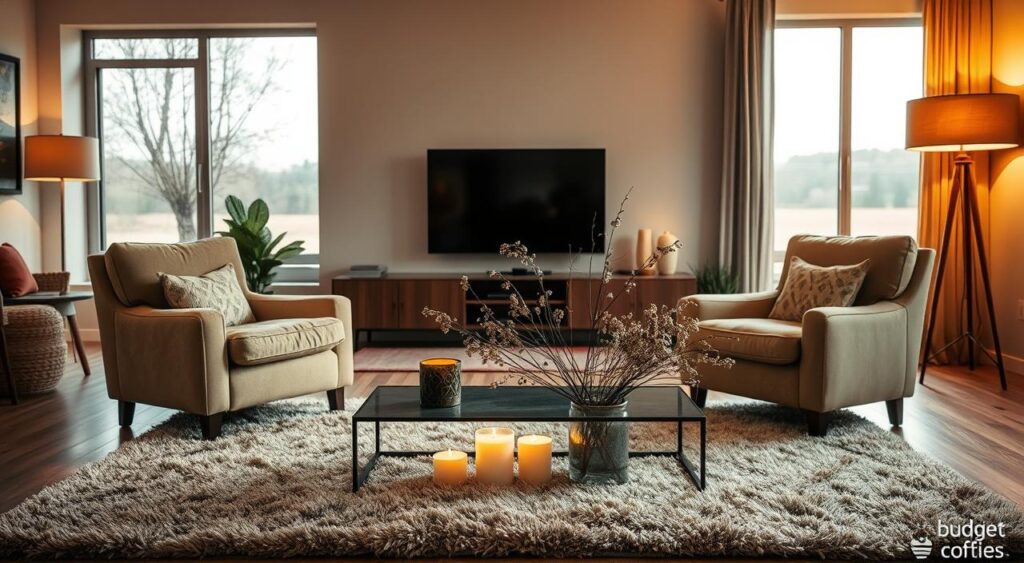
Small upgrades can have a significant impact. Begin with paint, the ultimate budget transformer. A bold front door in Benjamin Moore’s “International Orange” or a checkerboard kitchen backsplash using $1.50/sq ft subway tiles from Home Depot adds instant personality. Even a dimmer switch for under $15 can change a room’s vibe without a hefty cost.
- Light like a pro: Swap fixtures with sleek styles from IKEA. A $30 LED pendant over an island makes a statement. Mix warm and cool bulbs to mimic designer firm lighting setups.
- Hardware hacks: Replace drawer pulls with matte black finishes from Amazon—$8 each. One standout piece like a brushed brass cabinet knob ($12) elevates a whole kitchen.
- Smart surfaces: Cork flooring at $2-$5/sq ft offers eco-friendly warmth. Use peel-and-stick vinyl planks in bathrooms for a spa feel at 30% less than tile.
- Outdoor magic: Power-washing siding costs $100 vs $5,000 for repainting. Add potted geraniums at entryways for $5/pot—curb appeal on a shoestring.
- DIY drama: Build floating shelves with 1×12 pine boards from Home Depot. Stain to match your palette—$20 in materials for a custom look.
These money-saving home renovation tips show that luxury isn’t just about the label. Mix affordable home improvement ideas like a painted accent wall or a thrifted chandelier from Facebook Marketplace. This way, you can create a home that feels curated, not cramped. Every detail counts—start small and watch your space shine!
Navigating Permits and Regulations Without Unnecessary Expenses
Let’s dive into the paperwork side of budget home construction tips. Many homeowners worry about permits, but smart strategies can help. You can stay compliant without overspending. Here’s how to streamline the process while protecting your budget.
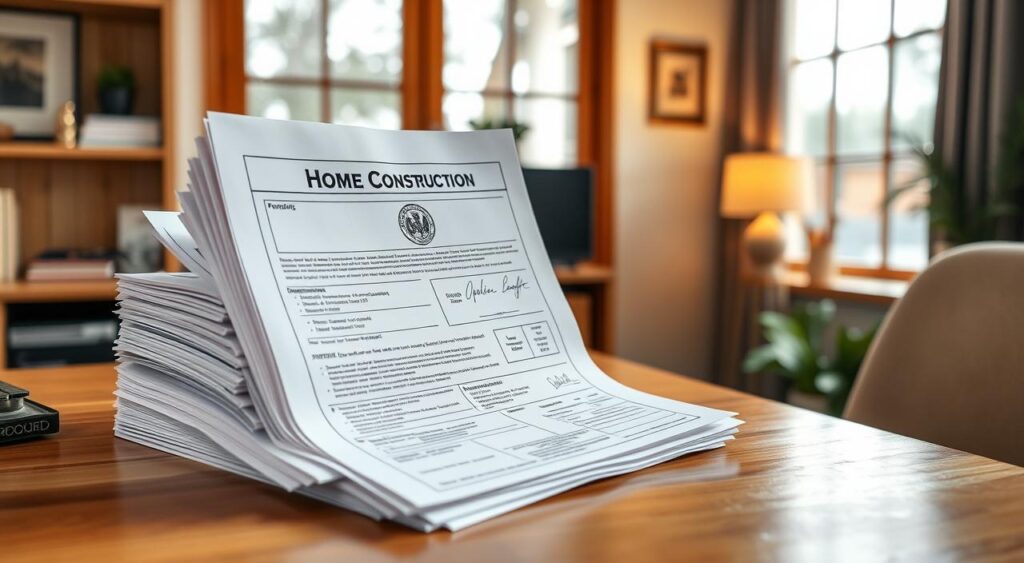
Understanding What Permits You Actually Need
First, map out exactly which permits apply to your project. Ask yourself:
- Does your region require a zoning variance for that backyard addition?
- Are electrical permits needed for your solar panel installation?
Don’t overpay for unnecessary permits. Research local codes online first – many counties post requirements publicly. Consulting architects early helps align designs with regulations from day one.
Working With Local Authorities Efficiently
Here’s how to make every interaction count:
- Submit complete applications – missing docs cause delays costing $100s in resubmissions
- Request fee schedules upfront to budget properly. Some permit fees range from $200-$2,000+ depending on scope
- Align inspection timing with construction phases to avoid halt orders
Avoiding Common Regulatory Pitfalls
Steer clear of these money-drains:
- Starting work before permits are finalized (fines up to 10% of project cost!)
- Ignoring historic district rules – one client spent $5k redoing a facade after violating preservation guidelines
- Forgetting to account for expedited fees (OT fees can add 30% to permit costs)
Pro hack: Use permit expediting services like PermitUsNow for large projects to avoid rushed fee surcharges. Budget home construction hacks often involve smart timing – apply during off-seasons when staff processes applications faster.
Remember: Proper planning turns permits into budget allies, not enemies. Allocate 3-5% of your budget for permit-related expenses. Always verify requirements with the city clerk’s office before breaking ground.
Conclusion: Building Your Dream Home Without Breaking the Bank
Starting to build your home within budget requires the budget home construction tips we’ve discussed. Every choice, from selecting affordable materials to focusing on your design, impacts your home’s value. Whether you’re handling DIY tasks or working with a contractor, making wise decisions keeps your dream alive.
DIY construction on a budget is not about cutting corners. It’s about finding a balance between creativity and practicality. For example, prefabricated homes can cut costs by 20-30% compared to traditional builds. Even small actions, like setting aside 10-20% for contingencies or bundling material orders, can help avoid overspending.
Sparks Construction highlights the importance of custom builders who help clients find affordable ways to achieve high-end looks. Avoiding last-minute design changes saves time and money. Having clear plans from the start also helps avoid hidden costs. Soft costs, like permits, can add 15-30%, so researching them early is key to keeping your budget in check.
Homeowners who stay true to their initial design and work with experienced professionals can save up to 25%. Prefab homes, efficient layouts, and repurposed materials can turn limitations into opportunities. Your dream home is within reach with careful planning, smart material choices, and the right team. Begin by listing your priorities and let every decision reflect your vision. With the right approach, your dream home can become a reality without breaking the bank. Build with strategy, not just effort, and your home will be both stunning and affordable.
FAQ
What are some budget-friendly construction techniques for first-time builders?
How can I save on materials without sacrificing quality?
What role does planning play in budget home construction?
Are there any DIY projects that I can tackle to save money?
How can energy efficiency impact my overall home construction costs?
What are some negotiation tactics when working with contractors?
How can I effectively phase my construction project to manage costs?
What common mistakes should I avoid during home construction?
What are some low-cost building materials I can consider?
How can I navigate building permits and regulations efficiently?

AUTHOR: MARIA JOSE VENTRAMELI
Specialist in Home Design, Architecture, and Trends
With years of experience writing for top home and lifestyle blogs, she now contributes to 17Vibes, offering practical, research-backed insights on renovations, smart technology, sustainable building, and modern living trends. Join our Facebook community here



